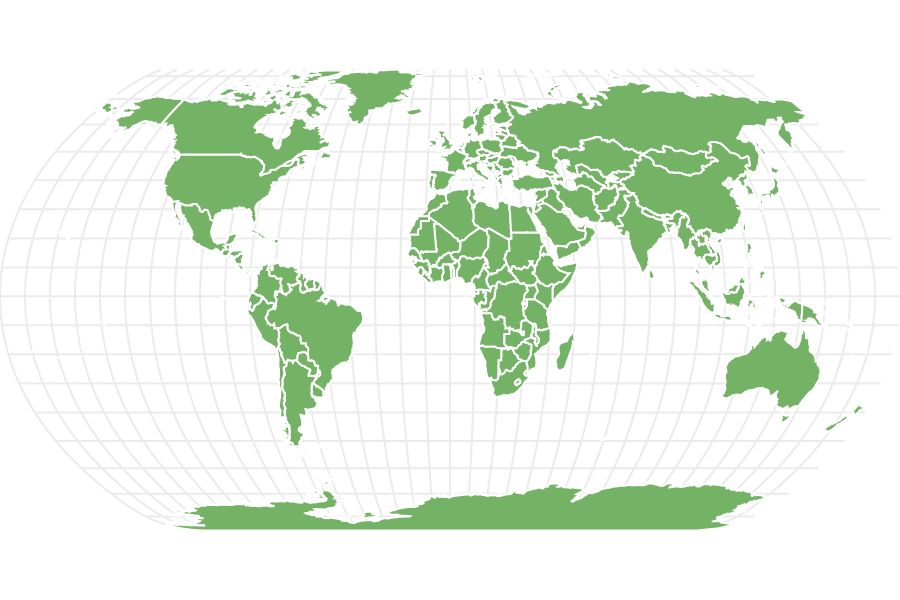Inchworm
Inchworms have no legs in the midsection of their body.
Advertisement
Inchworm Scientific Classification
Inchworm Facts
- Group Behavior
- Solitary/Group
- Fun Fact
- Inchworms have no legs in the midsection of their body.
- Most Distinctive Feature
- Absence of legs in the midsection of their body
- Distinctive Feature
- Inchworms have false legs on their posterior end
- Other Name(s)
- Loopers, cankerworms
- Habitat
- On the branches, leaves, and stems of trees
- Predators
- Predatory insects, birds, reptiles and amphibians
- Diet
- Herbivore
- Lifestyle
- terrestrial
- Type
- Larva
- Common Name
- Inchworms
- Special Features
- Inchworms move like they're measuring the ground with their body.
- Number Of Species
- 23000
View all of the Inchworm images!
Inchworms are the larvae of the geometer moth (family Geometridae). The caterpillar gets its name from its unique movement style, which seems like they’re measuring the ground. They move this way because they don’t have legs in the midsection of their body. Inchworms are mainly herbivorous, feeding on the bark, branches, and other parts of trees and shrubs. However, at least one species is carnivorous. Many inchworm species are considered destructive agricultural pests because they eat garden edibles and shade trees.
Inchworm Species, Types, and Scientific Name
Inchworms are caterpillars of moths in the family Geometridae. The moth derives its family name, “Geometridae,” from the Latin words “geo” and “metron.” The family name means “earth measuring,” referring to the unique looping motion of the larvae. The family Geometridae is a large one with more than 23,000 species described.
Inchworms don’t have the full complement of legs that many other caterpillars have. It has true legs on its anterior segment but only two to three pairs of prolegs at the posterior end (instead of the normal five pairs). To move, it first clasps with the front legs before pulling up the hind end or proleg. Then it grabs again with the prolegs and extends forward to seek a new forward attachment.
This creates the impression that it’s measuring its journey; hence, the name ‘inchworm” or “earth measurer.” This movement is mainly because it lacks any form of legs in the body’s midsection. The caterpillars go by several other names, including loopers or spanworms. However, people also call the larvae of other moths outside the family Geometridae “loopers,” even though they’re not true inchworms.
There are various known species of these measuring worms, with about 1,400 known in North America alone. Some common species are:
- Spring cankerworm (Paleacrita vernata)
- Fall cankerworm (Alsophilia pometaria)
- Linden looper (Erannis tillaria)
- Elm spanworm (Ennomos subsignaria)
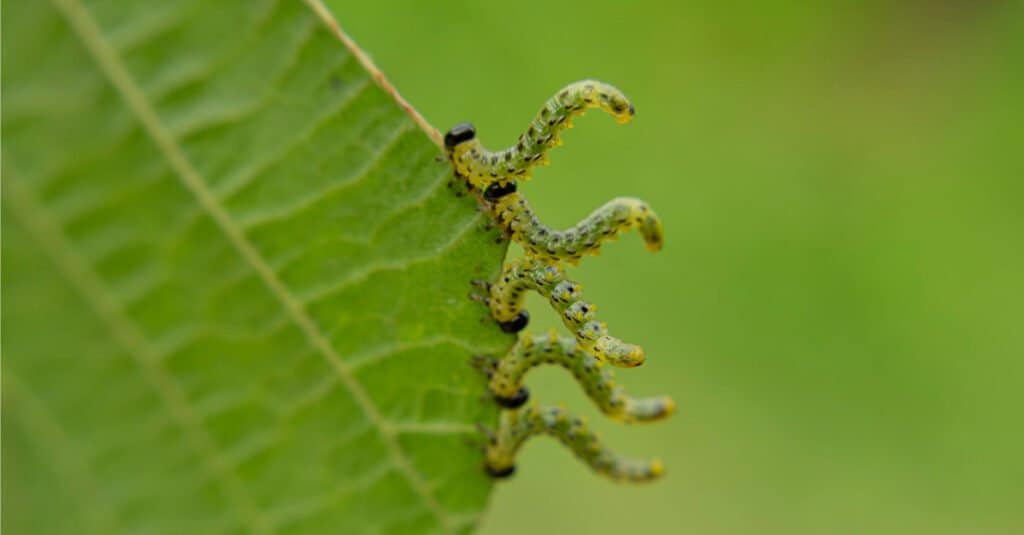
©iStock.com/DmitriiDivanov
Appearance — How To Identify Inchworms
Generally, the size of the inchworm depends on the species and maturity, but in many geometer moth species, the inchworms only measure about one inch. They have smooth bodies and are generally hairless.
Their color can vary from green to gray or black depending on the moth species into which the inchworm larva will be metamorphosed. But they also use these colors as a form of protection to camouflage and blend into their environment when hiding from predators. Some species of inchworms may also have black spots on their head. Apart from the vivid spots, they may also have patterns and stripes on their body. There’s a significant variation in the mature inchworm moths, though, with the color ranging from gray-brown, mint green, or dingy white to vibrant and bright color combinations.
The appearance of the inchworm makes it easy to identify. The location and distribution of their legs are distinguishing factors. They also have long, narrow bodies and may sometimes resemble twigs or sticks. So, you must be careful when spotting them in your garden.
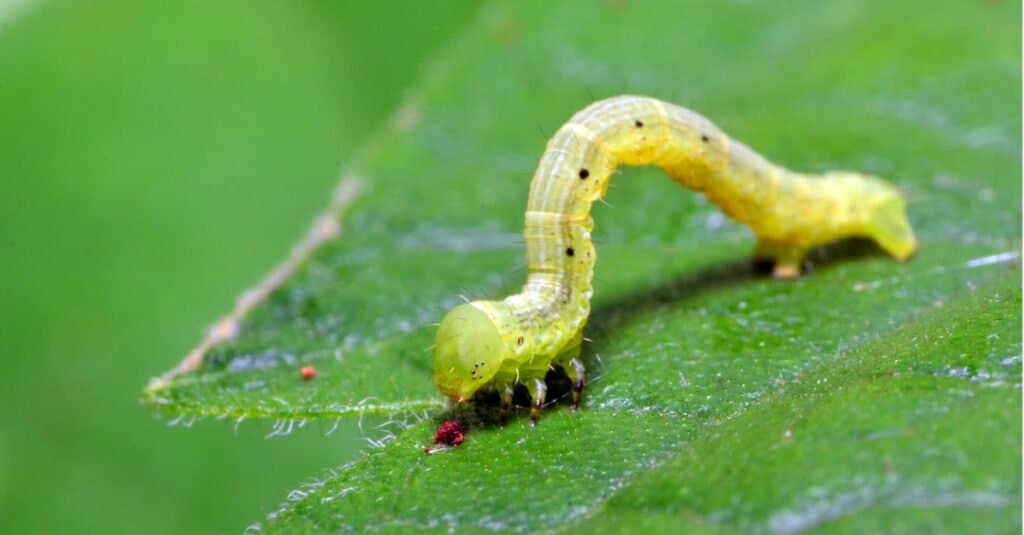
Inchworms can vary in color from green to gray or black and don’t have legs in the midsection of their body.
©iStock.com/wasantistock
Habitat — Where To Find Inchworms
Most inchworms are herbivores and always stay close to their food source. This is why you’re likely to see them on or close to branches, leaves, stems, and other parts of a plant they’re infesting.
Note that the inchworm stage is only the larva stage of the life cycle of a geometer moth. So, they spend most of this stage eating and trying to prepare themselves for the next phase of their life cycle. They rarely move far or travel elsewhere unless they’re ready to create a cocoon or spin silk.
Due to their adaptable and hardy nature, you can find inchworms across several habitats. Many gardeners and farmers consider them a major problem, especially when they exist in large groups or reach significant population levels. At this level, they can completely defoliate shrubs, groups of trees, and many other crops.
The commonest place where you’re likely to find them are regions where you have lush and dense foliage. They may assemble in forests, groves, orchards, and other natural areas. However, the moment they metamorphose into mature moths, they live a completely different and more mobile lifestyle.
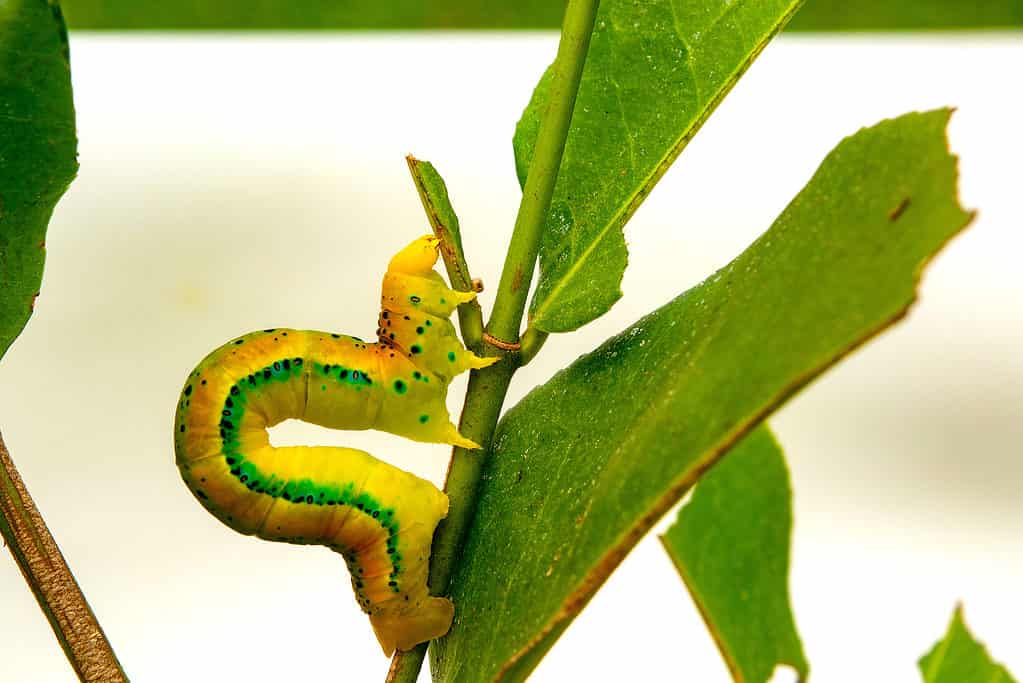
You will often find inchworms on the branches, leaves or stems of the plants they are feeding from.
©iStock.com/surasit bunnet
Evolution and History
German scientists in 2019 discovered the oldest fossil of a caterpillar they have ever found. The prehistoric larva, entombed in the amber, dates back to the Eocene Epoch and was estimated to be about 44 million years old. It was a type of inchworm, and the scientists named it Eogemeter.
While this was the oldest inchworm (or any other caterpillar, for that matter) ever found, moths have been around for quite a long time. Scientists believe the oldest members of the Lepidoptera order have been around since the Carboniferous. That’s some 300 million years ago. The evolution and diversification are often linked to the spread of angiosperms during the Carboniferous.
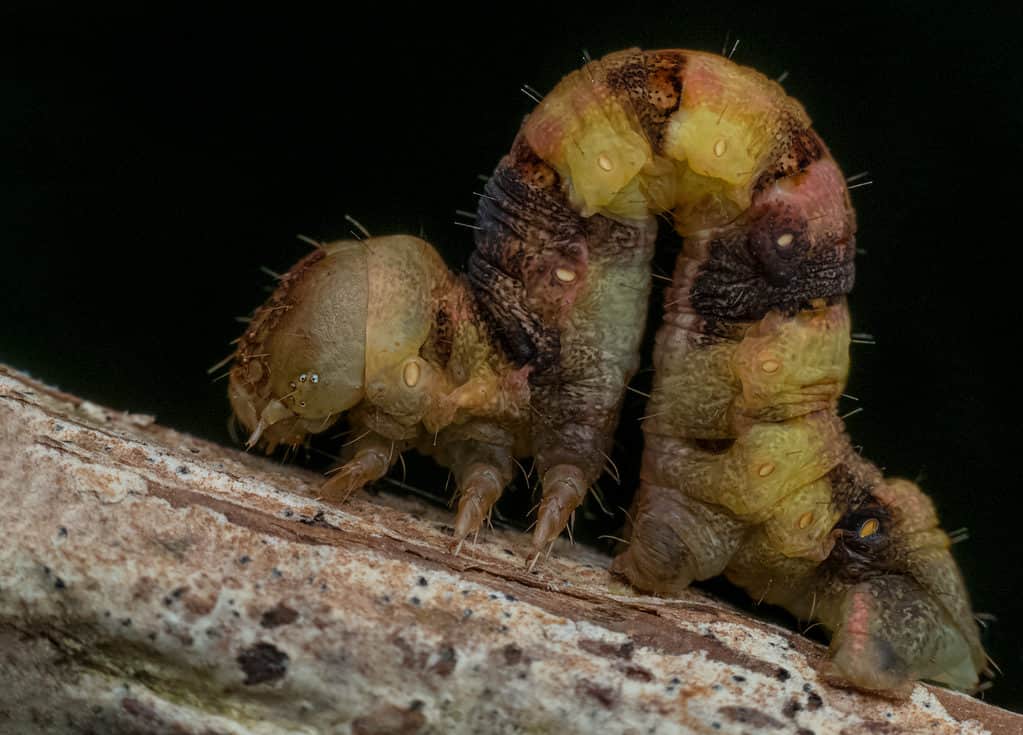
Due to their adaptable and hardy nature, you can find inchworms across several habitats.
©Dustin Rhoades/Shutterstock.com
Diet — What Do Inchworms Eat?
Generally, inchworms are considered to be social insects, and they’re known to gather together in groups on foliage, buds, and fruits of plants they infest. Even though they may assemble, they feed alone where they’re found. They primarily feed on the leaves of deciduous and coniferous trees, such as oaks, firs, elms, lindens, maples, and many fruit trees.
Inchworms are generally known to live on a herbivorous diet. However, there is at least one inchworm species that feeds on other insects and small creatures, like spiders, crickets, and flies.
The female inchworm lays the eggs and hides them on a tree’s bark or under leaves. Afterward, the larvae hatch and feed on the tree or plant structure they choose as their feeding ground. This is why many gardeners and farmers consider them unwelcome pests because they are destructive to the plant or tree they’ve chosen to feed on. If they’re left unchecked, they can feed on the leaves of a tree in their masses and destroy it completely before they move on to their next food source.
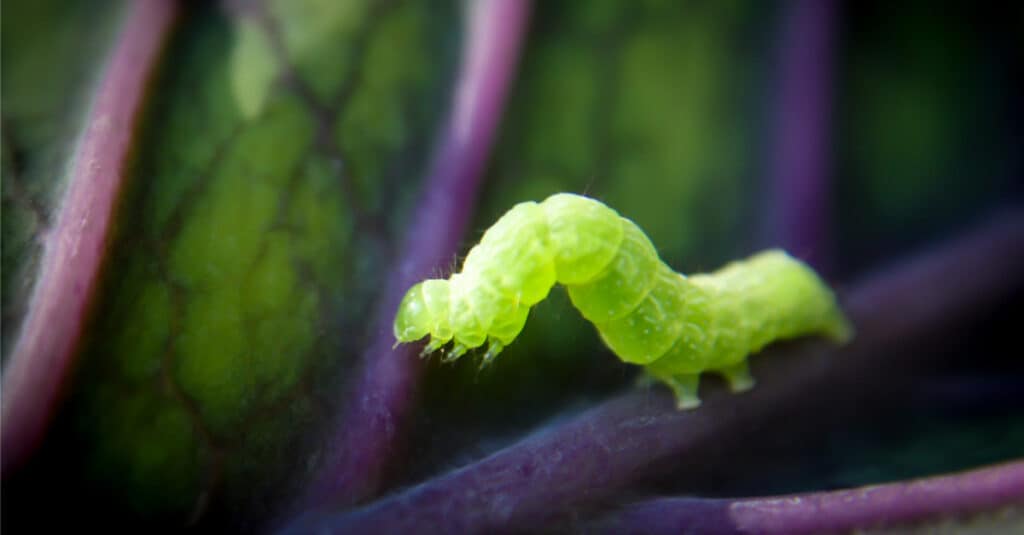
Inchworms are generally known to live on a herbivorous diet.
©iStock.com/Tpopove
What Eats Inchworms?
Many predatory insects feed on moth caterpillars like the inchworm. They include ground beetles, Trichogramma wasps, paper wasps, and yellow jackets. Some birds, reptiles, and amphibians also feed on the inchworm and adult moths.
Prevention — How To Get Rid of Inchworms
In most cases, it may not be necessary to control inchworms or try to get rid of them. This is because they don’t normally cause severe damage to healthy and stress-free trees. Additionally, the inchworm population is often controlled naturally by predators like beneficial insects and birds. However, if you find them present in large populations and feel it’s necessary to control them, you can try using chemical pesticides to get rid of them.
Firstly, be sure to use products that are approved for use in your area. Whatever pesticide you choose, ensure it’s safe for fruit trees and vegetable gardens. It’ll help if you read and understand the product labels extensively before applying them. You can use organic pesticides, such as natural pyrethrins, which are more gentle than synthetic chemical pesticides. However, you would need to apply them to the plant frequently. If you use a chemical insecticide, ensure that you never spray plants during their flower stage. Otherwise, you could kill pollinating insects too.
If the infestation isn’t very bad, you can hand-pick them and feed them to birds. You can also use row covers or insect-proof mesh to protect younger crops from these insects. Other possible barriers include sawdust, diatomaceous earth, or crushed eggshells.
Related Animals
View all 39 animals that start with IInchworm FAQs (Frequently Asked Questions)
Is an inchworm dangerous?
Inchworms are not dangerous to humans. But they can destroy the leaves of plants or trees, especially when they attack in large numbers.
How many legs does an inchworm have?
An inchworm has appendages at both ends. It has only two to three pairs of legs on its posterior end instead of at least five seen in the caterpillar of other moth species.
How do you identify inchworms?
Inchworms have smooth, hairless bodies. They’re about one inch long, without legs in the midsection of the body. They tend to move like they’re measuring the ground, which is the reason for their name.
How do you get rid of inchworms?
Their populations are controlled by predators naturally, so you may not need to get rid of them. But you can always use organic or chemical pesticides if you find them in large quantities and want to get rid of them. You may also pick them up manually to get rid of them.
Thank you for reading! Have some feedback for us? Contact the AZ Animals editorial team.
Sources
- GardenTech, Available here: https://www.gardentech.com/insects/inchworm
- All Things Nature, Available here: https://www.allthingsnature.org/what-are-inchworms.htm
- Wikipedia, Available here: https://en.wikipedia.org/wiki/Geometer_moth

